BABSH BAMH BAHRH BIS Report: Enterprise Systems and Big Data Analysis
VerifiedAdded on 2023/06/10
|12
|2942
|63
Report
AI Summary
This report examines the integration of Enterprise Systems (ES) and Big Data, highlighting their combined advantages. The introduction defines ES as software packages supporting business processes, data analysis, and information flows, including ERP and CRM systems. The discussion explores the efficiency, security, collaboration, and cost-effectiveness of ES, emphasizing its role in streamlining processes. Big Data is defined as large datasets beyond traditional processing capabilities, focusing on the 3Vs (volume, variety, velocity). The report then details the benefits of combining ES with Big Data, such as improved iteration, increased value, customer identification, better ROI, faster data access, and enhanced multi-channel analysis, culminating in the prediction of future business scenarios. The report concludes that this integration empowers businesses to optimize operations and gain a competitive edge.

Running head: BUSINESS INFORMATION SYSTEM
Business Information Systems
Name of the Student
Name of the University
Author’s Note:
Business Information Systems
Name of the Student
Name of the University
Author’s Note:
Paraphrase This Document
Need a fresh take? Get an instant paraphrase of this document with our AI Paraphraser
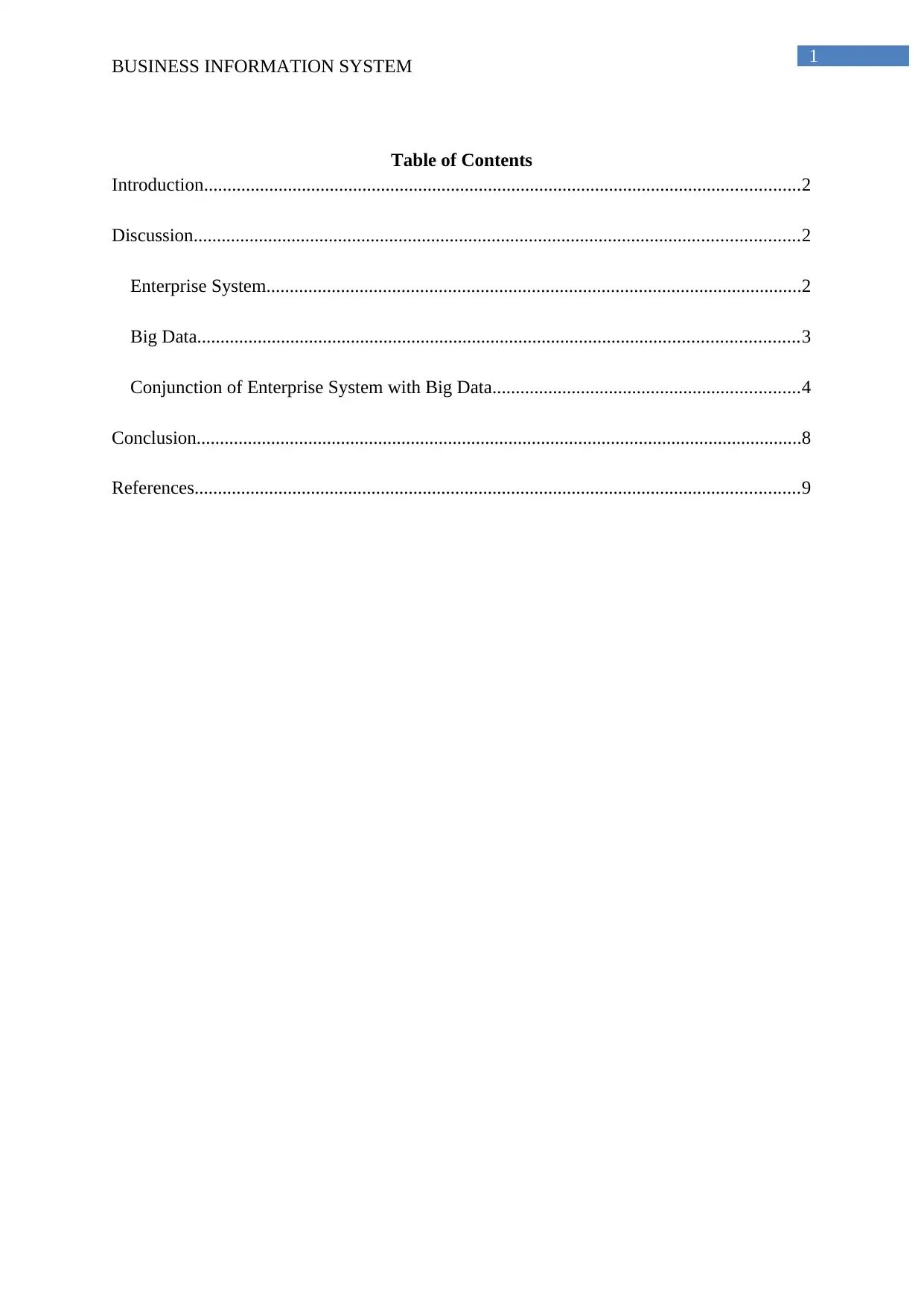
1
BUSINESS INFORMATION SYSTEM
Table of Contents
Introduction................................................................................................................................2
Discussion..................................................................................................................................2
Enterprise System...................................................................................................................2
Big Data.................................................................................................................................3
Conjunction of Enterprise System with Big Data..................................................................4
Conclusion..................................................................................................................................8
References..................................................................................................................................9
BUSINESS INFORMATION SYSTEM
Table of Contents
Introduction................................................................................................................................2
Discussion..................................................................................................................................2
Enterprise System...................................................................................................................2
Big Data.................................................................................................................................3
Conjunction of Enterprise System with Big Data..................................................................4
Conclusion..................................................................................................................................8
References..................................................................................................................................9
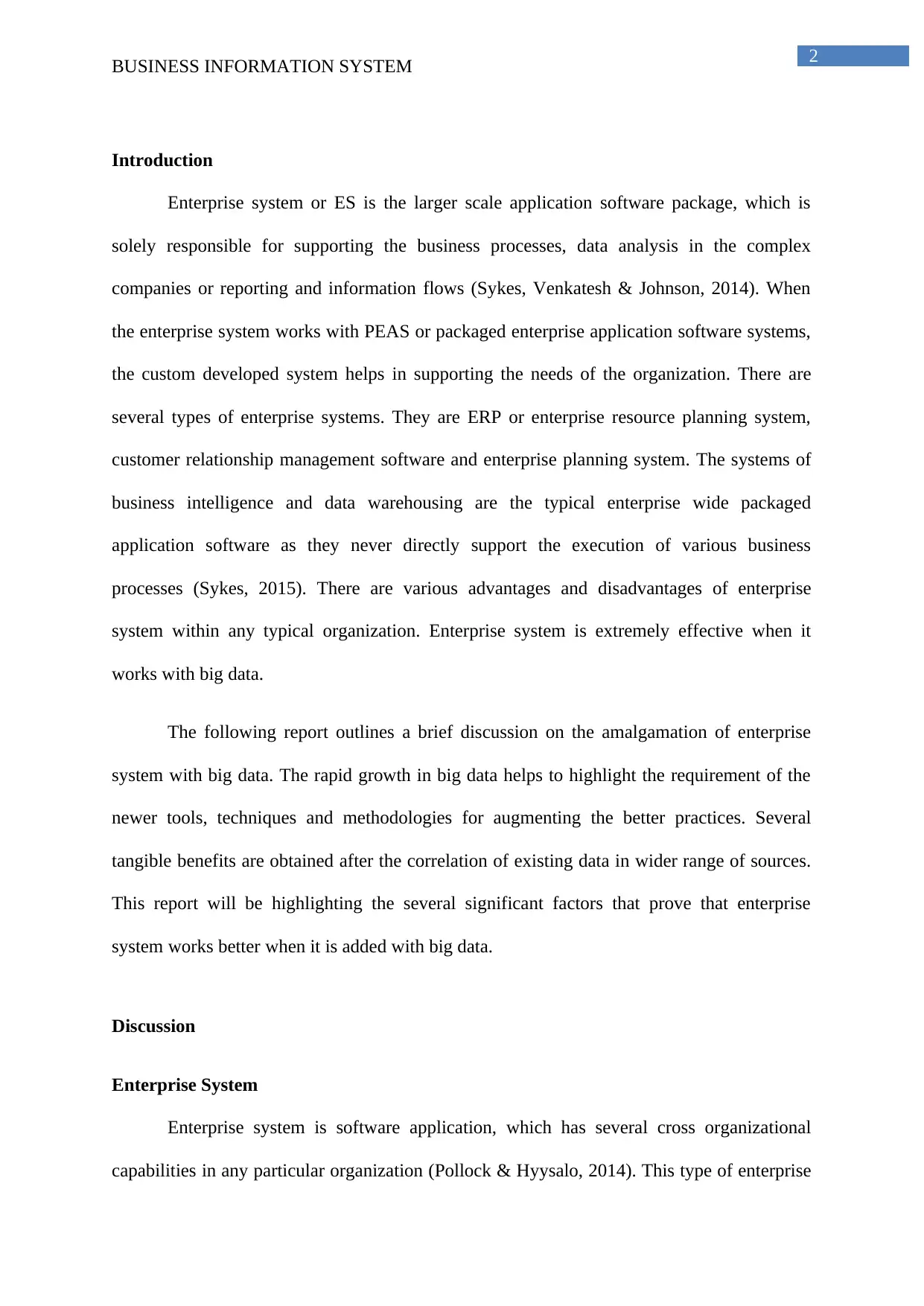
2
BUSINESS INFORMATION SYSTEM
Introduction
Enterprise system or ES is the larger scale application software package, which is
solely responsible for supporting the business processes, data analysis in the complex
companies or reporting and information flows (Sykes, Venkatesh & Johnson, 2014). When
the enterprise system works with PEAS or packaged enterprise application software systems,
the custom developed system helps in supporting the needs of the organization. There are
several types of enterprise systems. They are ERP or enterprise resource planning system,
customer relationship management software and enterprise planning system. The systems of
business intelligence and data warehousing are the typical enterprise wide packaged
application software as they never directly support the execution of various business
processes (Sykes, 2015). There are various advantages and disadvantages of enterprise
system within any typical organization. Enterprise system is extremely effective when it
works with big data.
The following report outlines a brief discussion on the amalgamation of enterprise
system with big data. The rapid growth in big data helps to highlight the requirement of the
newer tools, techniques and methodologies for augmenting the better practices. Several
tangible benefits are obtained after the correlation of existing data in wider range of sources.
This report will be highlighting the several significant factors that prove that enterprise
system works better when it is added with big data.
Discussion
Enterprise System
Enterprise system is software application, which has several cross organizational
capabilities in any particular organization (Pollock & Hyysalo, 2014). This type of enterprise
BUSINESS INFORMATION SYSTEM
Introduction
Enterprise system or ES is the larger scale application software package, which is
solely responsible for supporting the business processes, data analysis in the complex
companies or reporting and information flows (Sykes, Venkatesh & Johnson, 2014). When
the enterprise system works with PEAS or packaged enterprise application software systems,
the custom developed system helps in supporting the needs of the organization. There are
several types of enterprise systems. They are ERP or enterprise resource planning system,
customer relationship management software and enterprise planning system. The systems of
business intelligence and data warehousing are the typical enterprise wide packaged
application software as they never directly support the execution of various business
processes (Sykes, 2015). There are various advantages and disadvantages of enterprise
system within any typical organization. Enterprise system is extremely effective when it
works with big data.
The following report outlines a brief discussion on the amalgamation of enterprise
system with big data. The rapid growth in big data helps to highlight the requirement of the
newer tools, techniques and methodologies for augmenting the better practices. Several
tangible benefits are obtained after the correlation of existing data in wider range of sources.
This report will be highlighting the several significant factors that prove that enterprise
system works better when it is added with big data.
Discussion
Enterprise System
Enterprise system is software application, which has several cross organizational
capabilities in any particular organization (Pollock & Hyysalo, 2014). This type of enterprise
⊘ This is a preview!⊘
Do you want full access?
Subscribe today to unlock all pages.

Trusted by 1+ million students worldwide
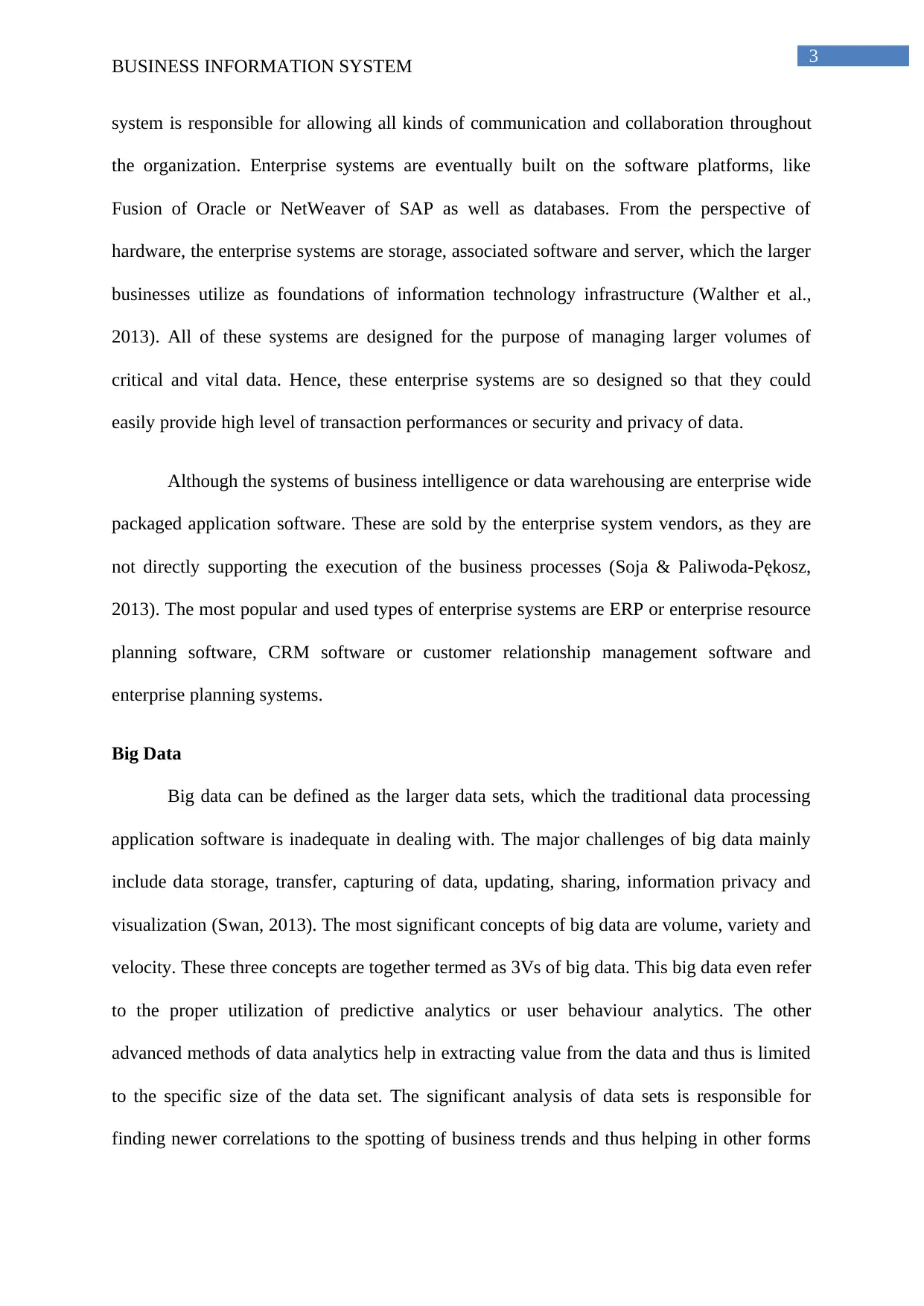
3
BUSINESS INFORMATION SYSTEM
system is responsible for allowing all kinds of communication and collaboration throughout
the organization. Enterprise systems are eventually built on the software platforms, like
Fusion of Oracle or NetWeaver of SAP as well as databases. From the perspective of
hardware, the enterprise systems are storage, associated software and server, which the larger
businesses utilize as foundations of information technology infrastructure (Walther et al.,
2013). All of these systems are designed for the purpose of managing larger volumes of
critical and vital data. Hence, these enterprise systems are so designed so that they could
easily provide high level of transaction performances or security and privacy of data.
Although the systems of business intelligence or data warehousing are enterprise wide
packaged application software. These are sold by the enterprise system vendors, as they are
not directly supporting the execution of the business processes (Soja & Paliwoda-Pękosz,
2013). The most popular and used types of enterprise systems are ERP or enterprise resource
planning software, CRM software or customer relationship management software and
enterprise planning systems.
Big Data
Big data can be defined as the larger data sets, which the traditional data processing
application software is inadequate in dealing with. The major challenges of big data mainly
include data storage, transfer, capturing of data, updating, sharing, information privacy and
visualization (Swan, 2013). The most significant concepts of big data are volume, variety and
velocity. These three concepts are together termed as 3Vs of big data. This big data even refer
to the proper utilization of predictive analytics or user behaviour analytics. The other
advanced methods of data analytics help in extracting value from the data and thus is limited
to the specific size of the data set. The significant analysis of data sets is responsible for
finding newer correlations to the spotting of business trends and thus helping in other forms
BUSINESS INFORMATION SYSTEM
system is responsible for allowing all kinds of communication and collaboration throughout
the organization. Enterprise systems are eventually built on the software platforms, like
Fusion of Oracle or NetWeaver of SAP as well as databases. From the perspective of
hardware, the enterprise systems are storage, associated software and server, which the larger
businesses utilize as foundations of information technology infrastructure (Walther et al.,
2013). All of these systems are designed for the purpose of managing larger volumes of
critical and vital data. Hence, these enterprise systems are so designed so that they could
easily provide high level of transaction performances or security and privacy of data.
Although the systems of business intelligence or data warehousing are enterprise wide
packaged application software. These are sold by the enterprise system vendors, as they are
not directly supporting the execution of the business processes (Soja & Paliwoda-Pękosz,
2013). The most popular and used types of enterprise systems are ERP or enterprise resource
planning software, CRM software or customer relationship management software and
enterprise planning systems.
Big Data
Big data can be defined as the larger data sets, which the traditional data processing
application software is inadequate in dealing with. The major challenges of big data mainly
include data storage, transfer, capturing of data, updating, sharing, information privacy and
visualization (Swan, 2013). The most significant concepts of big data are volume, variety and
velocity. These three concepts are together termed as 3Vs of big data. This big data even refer
to the proper utilization of predictive analytics or user behaviour analytics. The other
advanced methods of data analytics help in extracting value from the data and thus is limited
to the specific size of the data set. The significant analysis of data sets is responsible for
finding newer correlations to the spotting of business trends and thus helping in other forms
Paraphrase This Document
Need a fresh take? Get an instant paraphrase of this document with our AI Paraphraser
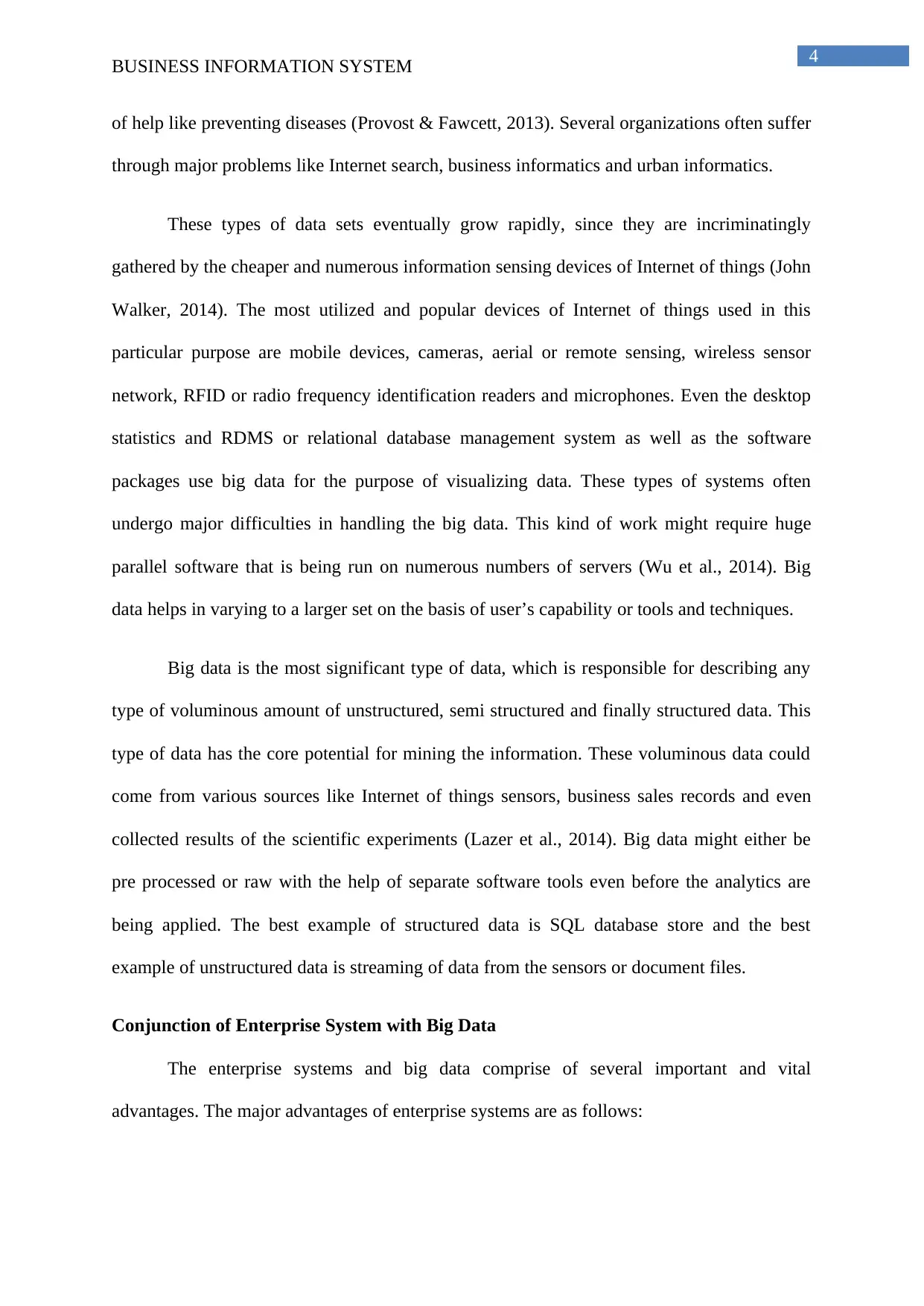
4
BUSINESS INFORMATION SYSTEM
of help like preventing diseases (Provost & Fawcett, 2013). Several organizations often suffer
through major problems like Internet search, business informatics and urban informatics.
These types of data sets eventually grow rapidly, since they are incriminatingly
gathered by the cheaper and numerous information sensing devices of Internet of things (John
Walker, 2014). The most utilized and popular devices of Internet of things used in this
particular purpose are mobile devices, cameras, aerial or remote sensing, wireless sensor
network, RFID or radio frequency identification readers and microphones. Even the desktop
statistics and RDMS or relational database management system as well as the software
packages use big data for the purpose of visualizing data. These types of systems often
undergo major difficulties in handling the big data. This kind of work might require huge
parallel software that is being run on numerous numbers of servers (Wu et al., 2014). Big
data helps in varying to a larger set on the basis of user’s capability or tools and techniques.
Big data is the most significant type of data, which is responsible for describing any
type of voluminous amount of unstructured, semi structured and finally structured data. This
type of data has the core potential for mining the information. These voluminous data could
come from various sources like Internet of things sensors, business sales records and even
collected results of the scientific experiments (Lazer et al., 2014). Big data might either be
pre processed or raw with the help of separate software tools even before the analytics are
being applied. The best example of structured data is SQL database store and the best
example of unstructured data is streaming of data from the sensors or document files.
Conjunction of Enterprise System with Big Data
The enterprise systems and big data comprise of several important and vital
advantages. The major advantages of enterprise systems are as follows:
BUSINESS INFORMATION SYSTEM
of help like preventing diseases (Provost & Fawcett, 2013). Several organizations often suffer
through major problems like Internet search, business informatics and urban informatics.
These types of data sets eventually grow rapidly, since they are incriminatingly
gathered by the cheaper and numerous information sensing devices of Internet of things (John
Walker, 2014). The most utilized and popular devices of Internet of things used in this
particular purpose are mobile devices, cameras, aerial or remote sensing, wireless sensor
network, RFID or radio frequency identification readers and microphones. Even the desktop
statistics and RDMS or relational database management system as well as the software
packages use big data for the purpose of visualizing data. These types of systems often
undergo major difficulties in handling the big data. This kind of work might require huge
parallel software that is being run on numerous numbers of servers (Wu et al., 2014). Big
data helps in varying to a larger set on the basis of user’s capability or tools and techniques.
Big data is the most significant type of data, which is responsible for describing any
type of voluminous amount of unstructured, semi structured and finally structured data. This
type of data has the core potential for mining the information. These voluminous data could
come from various sources like Internet of things sensors, business sales records and even
collected results of the scientific experiments (Lazer et al., 2014). Big data might either be
pre processed or raw with the help of separate software tools even before the analytics are
being applied. The best example of structured data is SQL database store and the best
example of unstructured data is streaming of data from the sensors or document files.
Conjunction of Enterprise System with Big Data
The enterprise systems and big data comprise of several important and vital
advantages. The major advantages of enterprise systems are as follows:
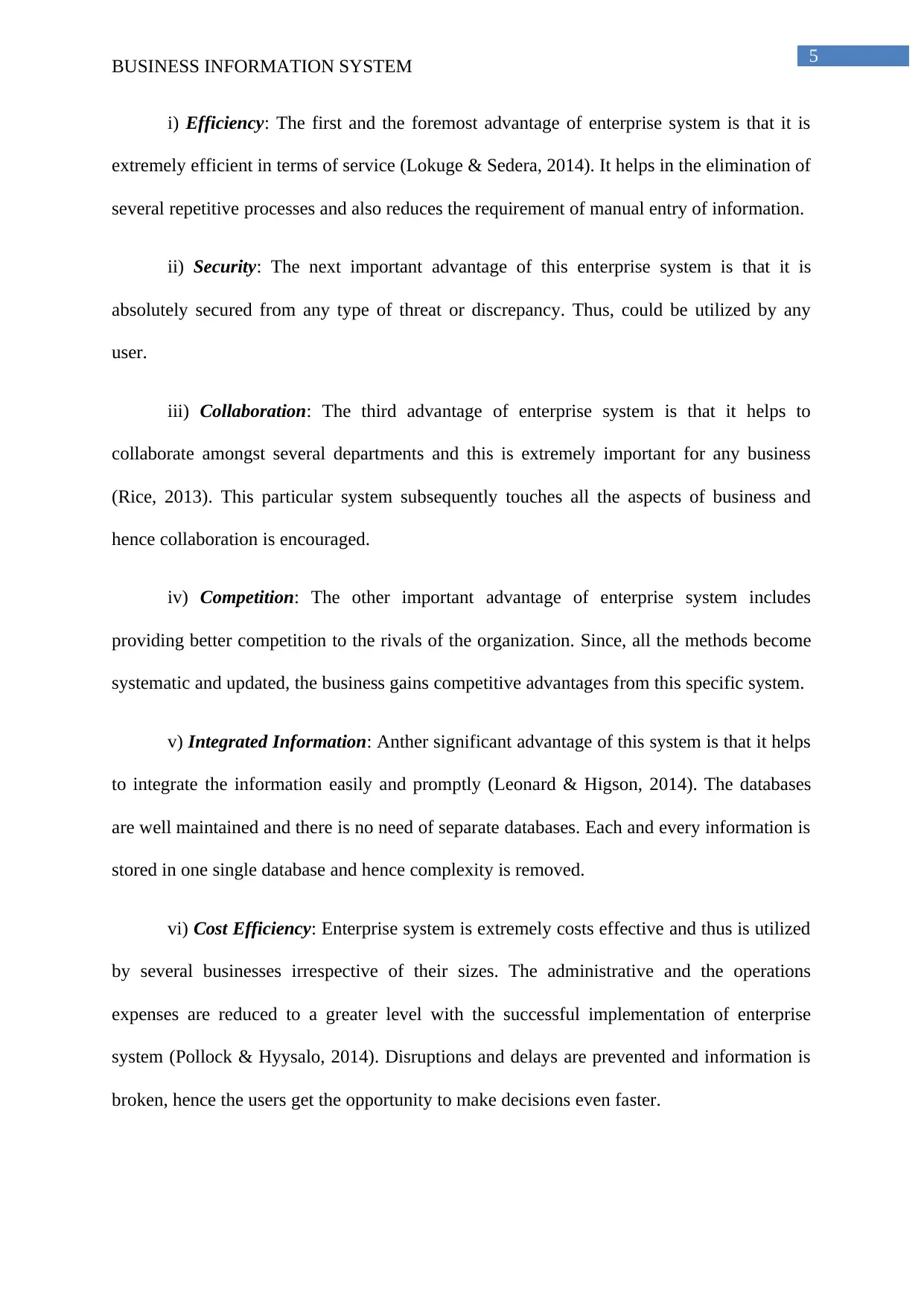
5
BUSINESS INFORMATION SYSTEM
i) Efficiency: The first and the foremost advantage of enterprise system is that it is
extremely efficient in terms of service (Lokuge & Sedera, 2014). It helps in the elimination of
several repetitive processes and also reduces the requirement of manual entry of information.
ii) Security: The next important advantage of this enterprise system is that it is
absolutely secured from any type of threat or discrepancy. Thus, could be utilized by any
user.
iii) Collaboration: The third advantage of enterprise system is that it helps to
collaborate amongst several departments and this is extremely important for any business
(Rice, 2013). This particular system subsequently touches all the aspects of business and
hence collaboration is encouraged.
iv) Competition: The other important advantage of enterprise system includes
providing better competition to the rivals of the organization. Since, all the methods become
systematic and updated, the business gains competitive advantages from this specific system.
v) Integrated Information: Anther significant advantage of this system is that it helps
to integrate the information easily and promptly (Leonard & Higson, 2014). The databases
are well maintained and there is no need of separate databases. Each and every information is
stored in one single database and hence complexity is removed.
vi) Cost Efficiency: Enterprise system is extremely costs effective and thus is utilized
by several businesses irrespective of their sizes. The administrative and the operations
expenses are reduced to a greater level with the successful implementation of enterprise
system (Pollock & Hyysalo, 2014). Disruptions and delays are prevented and information is
broken, hence the users get the opportunity to make decisions even faster.
BUSINESS INFORMATION SYSTEM
i) Efficiency: The first and the foremost advantage of enterprise system is that it is
extremely efficient in terms of service (Lokuge & Sedera, 2014). It helps in the elimination of
several repetitive processes and also reduces the requirement of manual entry of information.
ii) Security: The next important advantage of this enterprise system is that it is
absolutely secured from any type of threat or discrepancy. Thus, could be utilized by any
user.
iii) Collaboration: The third advantage of enterprise system is that it helps to
collaborate amongst several departments and this is extremely important for any business
(Rice, 2013). This particular system subsequently touches all the aspects of business and
hence collaboration is encouraged.
iv) Competition: The other important advantage of enterprise system includes
providing better competition to the rivals of the organization. Since, all the methods become
systematic and updated, the business gains competitive advantages from this specific system.
v) Integrated Information: Anther significant advantage of this system is that it helps
to integrate the information easily and promptly (Leonard & Higson, 2014). The databases
are well maintained and there is no need of separate databases. Each and every information is
stored in one single database and hence complexity is removed.
vi) Cost Efficiency: Enterprise system is extremely costs effective and thus is utilized
by several businesses irrespective of their sizes. The administrative and the operations
expenses are reduced to a greater level with the successful implementation of enterprise
system (Pollock & Hyysalo, 2014). Disruptions and delays are prevented and information is
broken, hence the users get the opportunity to make decisions even faster.
⊘ This is a preview!⊘
Do you want full access?
Subscribe today to unlock all pages.

Trusted by 1+ million students worldwide
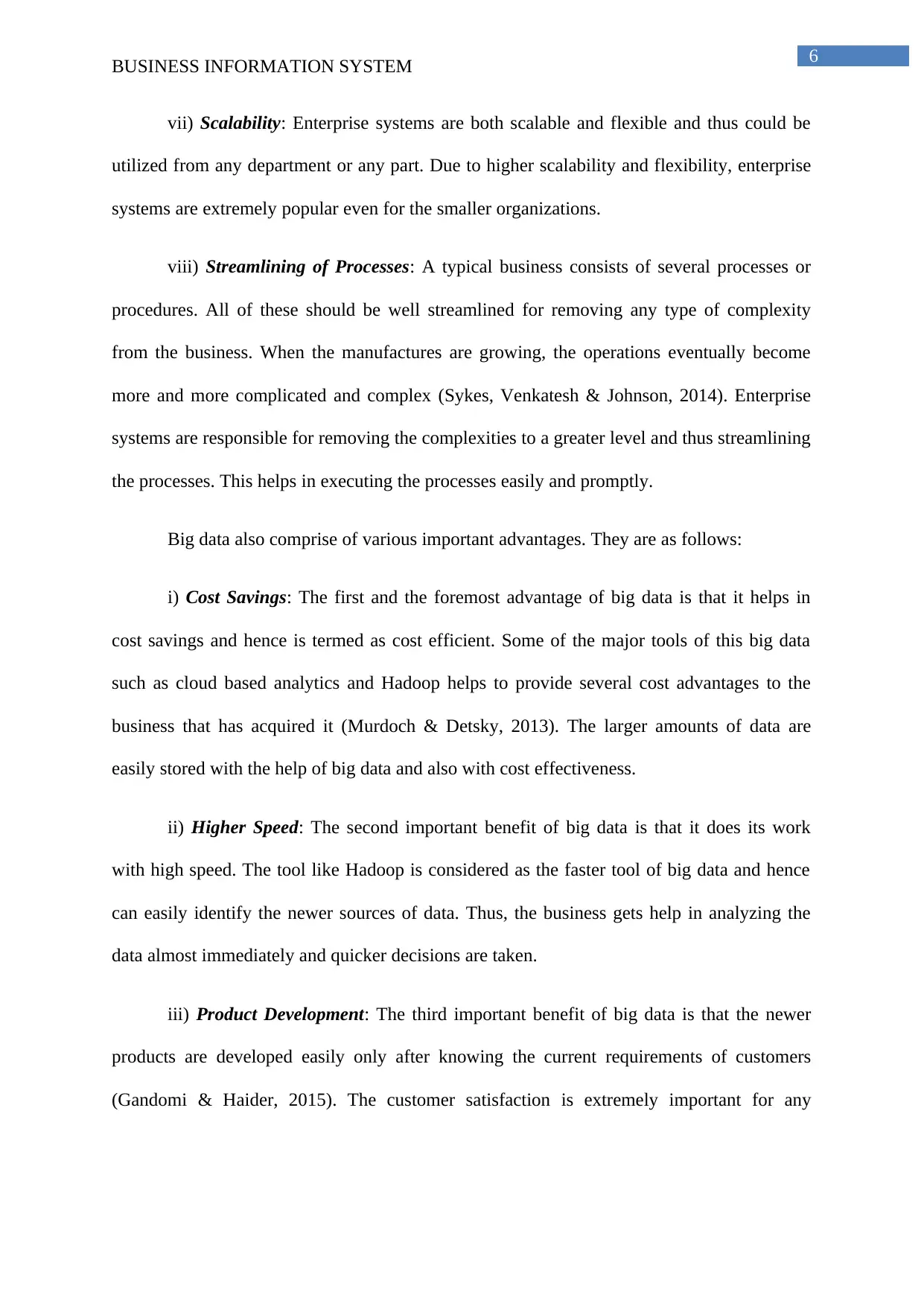
6
BUSINESS INFORMATION SYSTEM
vii) Scalability: Enterprise systems are both scalable and flexible and thus could be
utilized from any department or any part. Due to higher scalability and flexibility, enterprise
systems are extremely popular even for the smaller organizations.
viii) Streamlining of Processes: A typical business consists of several processes or
procedures. All of these should be well streamlined for removing any type of complexity
from the business. When the manufactures are growing, the operations eventually become
more and more complicated and complex (Sykes, Venkatesh & Johnson, 2014). Enterprise
systems are responsible for removing the complexities to a greater level and thus streamlining
the processes. This helps in executing the processes easily and promptly.
Big data also comprise of various important advantages. They are as follows:
i) Cost Savings: The first and the foremost advantage of big data is that it helps in
cost savings and hence is termed as cost efficient. Some of the major tools of this big data
such as cloud based analytics and Hadoop helps to provide several cost advantages to the
business that has acquired it (Murdoch & Detsky, 2013). The larger amounts of data are
easily stored with the help of big data and also with cost effectiveness.
ii) Higher Speed: The second important benefit of big data is that it does its work
with high speed. The tool like Hadoop is considered as the faster tool of big data and hence
can easily identify the newer sources of data. Thus, the business gets help in analyzing the
data almost immediately and quicker decisions are taken.
iii) Product Development: The third important benefit of big data is that the newer
products are developed easily only after knowing the current requirements of customers
(Gandomi & Haider, 2015). The customer satisfaction is extremely important for any
BUSINESS INFORMATION SYSTEM
vii) Scalability: Enterprise systems are both scalable and flexible and thus could be
utilized from any department or any part. Due to higher scalability and flexibility, enterprise
systems are extremely popular even for the smaller organizations.
viii) Streamlining of Processes: A typical business consists of several processes or
procedures. All of these should be well streamlined for removing any type of complexity
from the business. When the manufactures are growing, the operations eventually become
more and more complicated and complex (Sykes, Venkatesh & Johnson, 2014). Enterprise
systems are responsible for removing the complexities to a greater level and thus streamlining
the processes. This helps in executing the processes easily and promptly.
Big data also comprise of various important advantages. They are as follows:
i) Cost Savings: The first and the foremost advantage of big data is that it helps in
cost savings and hence is termed as cost efficient. Some of the major tools of this big data
such as cloud based analytics and Hadoop helps to provide several cost advantages to the
business that has acquired it (Murdoch & Detsky, 2013). The larger amounts of data are
easily stored with the help of big data and also with cost effectiveness.
ii) Higher Speed: The second important benefit of big data is that it does its work
with high speed. The tool like Hadoop is considered as the faster tool of big data and hence
can easily identify the newer sources of data. Thus, the business gets help in analyzing the
data almost immediately and quicker decisions are taken.
iii) Product Development: The third important benefit of big data is that the newer
products are developed easily only after knowing the current requirements of customers
(Gandomi & Haider, 2015). The customer satisfaction is extremely important for any
Paraphrase This Document
Need a fresh take? Get an instant paraphrase of this document with our AI Paraphraser
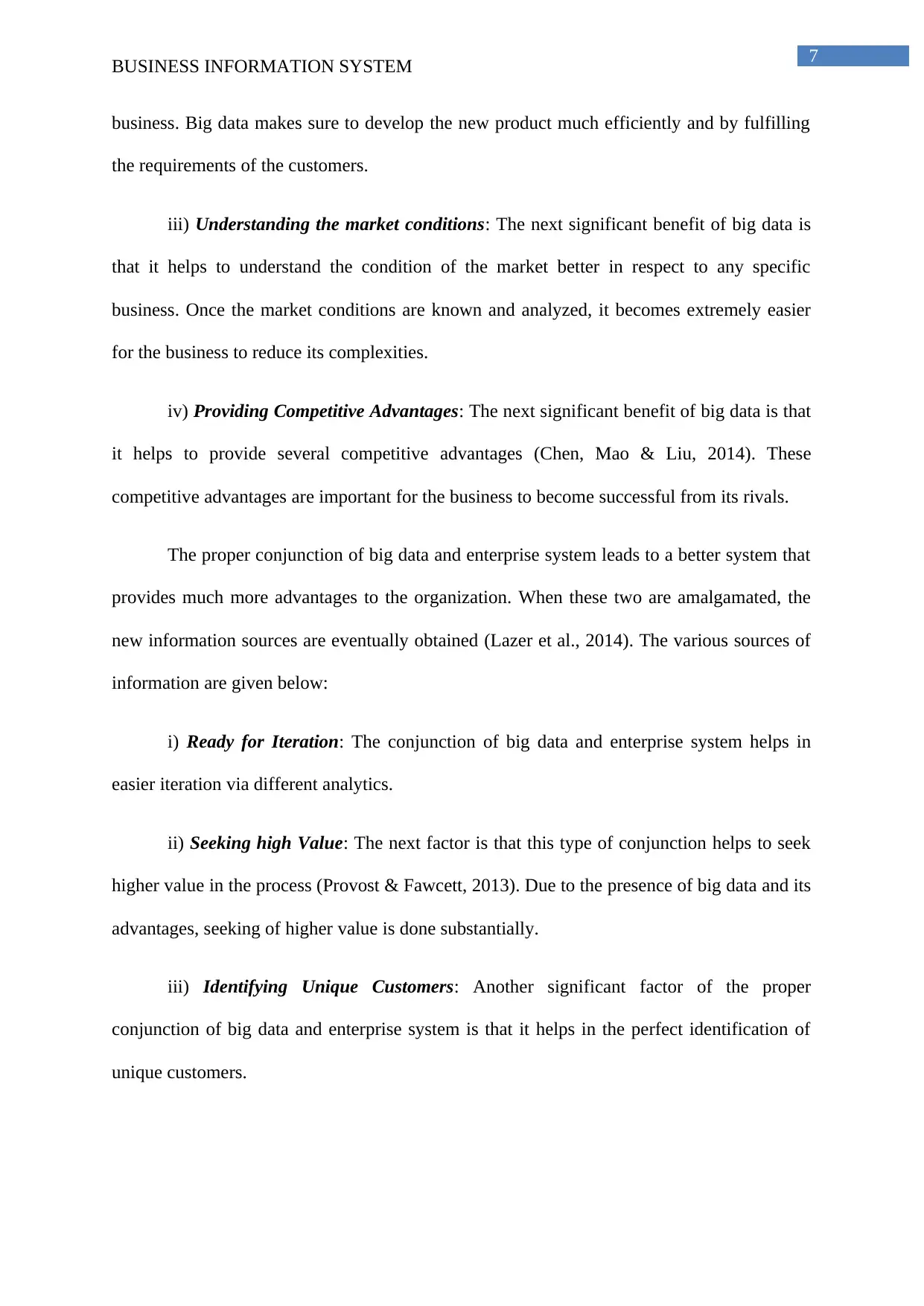
7
BUSINESS INFORMATION SYSTEM
business. Big data makes sure to develop the new product much efficiently and by fulfilling
the requirements of the customers.
iii) Understanding the market conditions: The next significant benefit of big data is
that it helps to understand the condition of the market better in respect to any specific
business. Once the market conditions are known and analyzed, it becomes extremely easier
for the business to reduce its complexities.
iv) Providing Competitive Advantages: The next significant benefit of big data is that
it helps to provide several competitive advantages (Chen, Mao & Liu, 2014). These
competitive advantages are important for the business to become successful from its rivals.
The proper conjunction of big data and enterprise system leads to a better system that
provides much more advantages to the organization. When these two are amalgamated, the
new information sources are eventually obtained (Lazer et al., 2014). The various sources of
information are given below:
i) Ready for Iteration: The conjunction of big data and enterprise system helps in
easier iteration via different analytics.
ii) Seeking high Value: The next factor is that this type of conjunction helps to seek
higher value in the process (Provost & Fawcett, 2013). Due to the presence of big data and its
advantages, seeking of higher value is done substantially.
iii) Identifying Unique Customers: Another significant factor of the proper
conjunction of big data and enterprise system is that it helps in the perfect identification of
unique customers.
BUSINESS INFORMATION SYSTEM
business. Big data makes sure to develop the new product much efficiently and by fulfilling
the requirements of the customers.
iii) Understanding the market conditions: The next significant benefit of big data is
that it helps to understand the condition of the market better in respect to any specific
business. Once the market conditions are known and analyzed, it becomes extremely easier
for the business to reduce its complexities.
iv) Providing Competitive Advantages: The next significant benefit of big data is that
it helps to provide several competitive advantages (Chen, Mao & Liu, 2014). These
competitive advantages are important for the business to become successful from its rivals.
The proper conjunction of big data and enterprise system leads to a better system that
provides much more advantages to the organization. When these two are amalgamated, the
new information sources are eventually obtained (Lazer et al., 2014). The various sources of
information are given below:
i) Ready for Iteration: The conjunction of big data and enterprise system helps in
easier iteration via different analytics.
ii) Seeking high Value: The next factor is that this type of conjunction helps to seek
higher value in the process (Provost & Fawcett, 2013). Due to the presence of big data and its
advantages, seeking of higher value is done substantially.
iii) Identifying Unique Customers: Another significant factor of the proper
conjunction of big data and enterprise system is that it helps in the perfect identification of
unique customers.
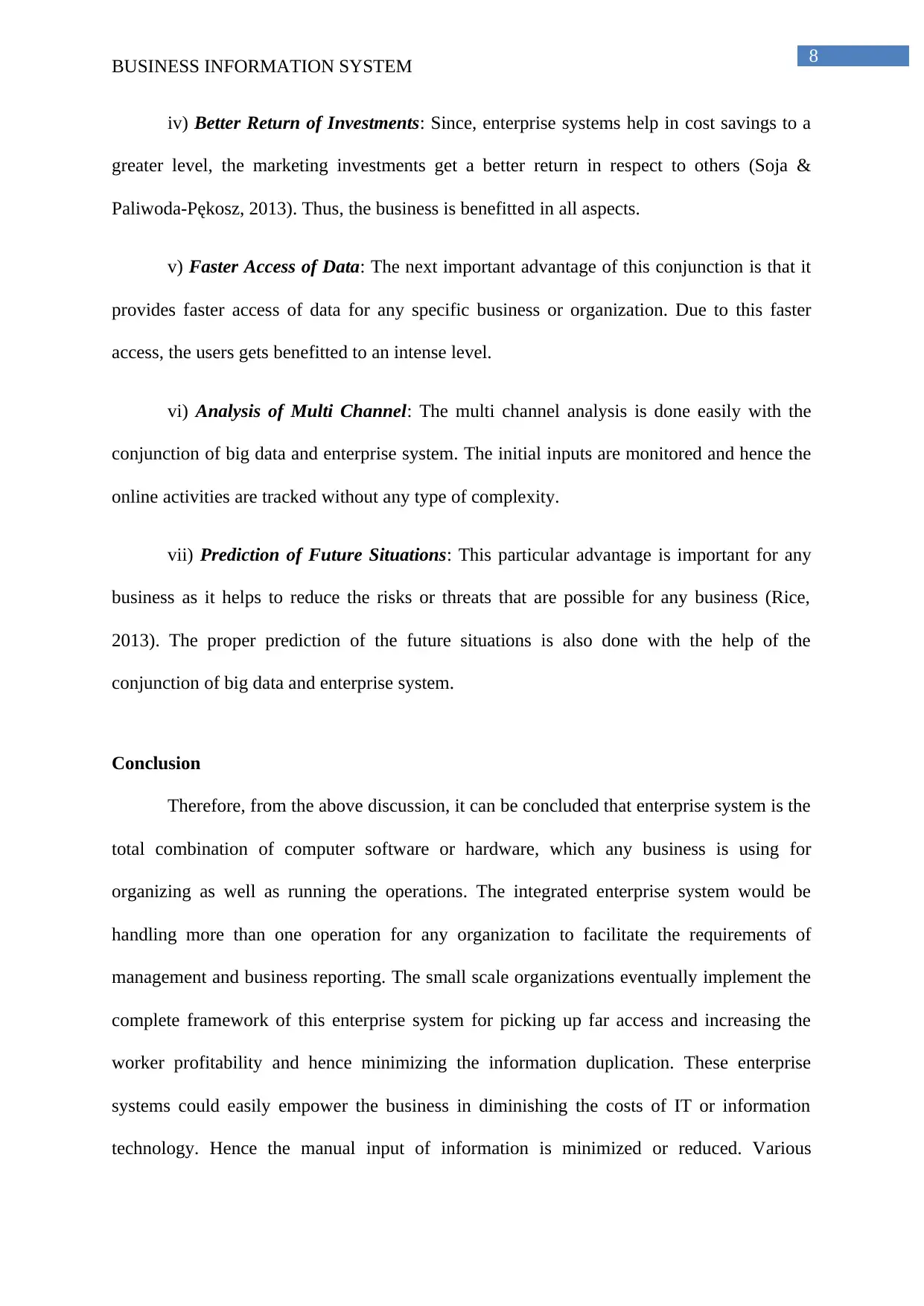
8
BUSINESS INFORMATION SYSTEM
iv) Better Return of Investments: Since, enterprise systems help in cost savings to a
greater level, the marketing investments get a better return in respect to others (Soja &
Paliwoda-Pękosz, 2013). Thus, the business is benefitted in all aspects.
v) Faster Access of Data: The next important advantage of this conjunction is that it
provides faster access of data for any specific business or organization. Due to this faster
access, the users gets benefitted to an intense level.
vi) Analysis of Multi Channel: The multi channel analysis is done easily with the
conjunction of big data and enterprise system. The initial inputs are monitored and hence the
online activities are tracked without any type of complexity.
vii) Prediction of Future Situations: This particular advantage is important for any
business as it helps to reduce the risks or threats that are possible for any business (Rice,
2013). The proper prediction of the future situations is also done with the help of the
conjunction of big data and enterprise system.
Conclusion
Therefore, from the above discussion, it can be concluded that enterprise system is the
total combination of computer software or hardware, which any business is using for
organizing as well as running the operations. The integrated enterprise system would be
handling more than one operation for any organization to facilitate the requirements of
management and business reporting. The small scale organizations eventually implement the
complete framework of this enterprise system for picking up far access and increasing the
worker profitability and hence minimizing the information duplication. These enterprise
systems could easily empower the business in diminishing the costs of IT or information
technology. Hence the manual input of information is minimized or reduced. Various
BUSINESS INFORMATION SYSTEM
iv) Better Return of Investments: Since, enterprise systems help in cost savings to a
greater level, the marketing investments get a better return in respect to others (Soja &
Paliwoda-Pękosz, 2013). Thus, the business is benefitted in all aspects.
v) Faster Access of Data: The next important advantage of this conjunction is that it
provides faster access of data for any specific business or organization. Due to this faster
access, the users gets benefitted to an intense level.
vi) Analysis of Multi Channel: The multi channel analysis is done easily with the
conjunction of big data and enterprise system. The initial inputs are monitored and hence the
online activities are tracked without any type of complexity.
vii) Prediction of Future Situations: This particular advantage is important for any
business as it helps to reduce the risks or threats that are possible for any business (Rice,
2013). The proper prediction of the future situations is also done with the help of the
conjunction of big data and enterprise system.
Conclusion
Therefore, from the above discussion, it can be concluded that enterprise system is the
total combination of computer software or hardware, which any business is using for
organizing as well as running the operations. The integrated enterprise system would be
handling more than one operation for any organization to facilitate the requirements of
management and business reporting. The small scale organizations eventually implement the
complete framework of this enterprise system for picking up far access and increasing the
worker profitability and hence minimizing the information duplication. These enterprise
systems could easily empower the business in diminishing the costs of IT or information
technology. Hence the manual input of information is minimized or reduced. Various
⊘ This is a preview!⊘
Do you want full access?
Subscribe today to unlock all pages.

Trusted by 1+ million students worldwide

9
BUSINESS INFORMATION SYSTEM
significant advantages are present for the enterprise system and hence big data is being used
with this specific type of system. The above report has clearly outlined the topic of enterprise
system with the configuration of big data. This big data comprises of the inherent focus on
various new information sources that are originating from wider range of providers. The
several types of advantages are present for the enterprise systems with big data. Relevant
details are provided in this report.
BUSINESS INFORMATION SYSTEM
significant advantages are present for the enterprise system and hence big data is being used
with this specific type of system. The above report has clearly outlined the topic of enterprise
system with the configuration of big data. This big data comprises of the inherent focus on
various new information sources that are originating from wider range of providers. The
several types of advantages are present for the enterprise systems with big data. Relevant
details are provided in this report.
Paraphrase This Document
Need a fresh take? Get an instant paraphrase of this document with our AI Paraphraser
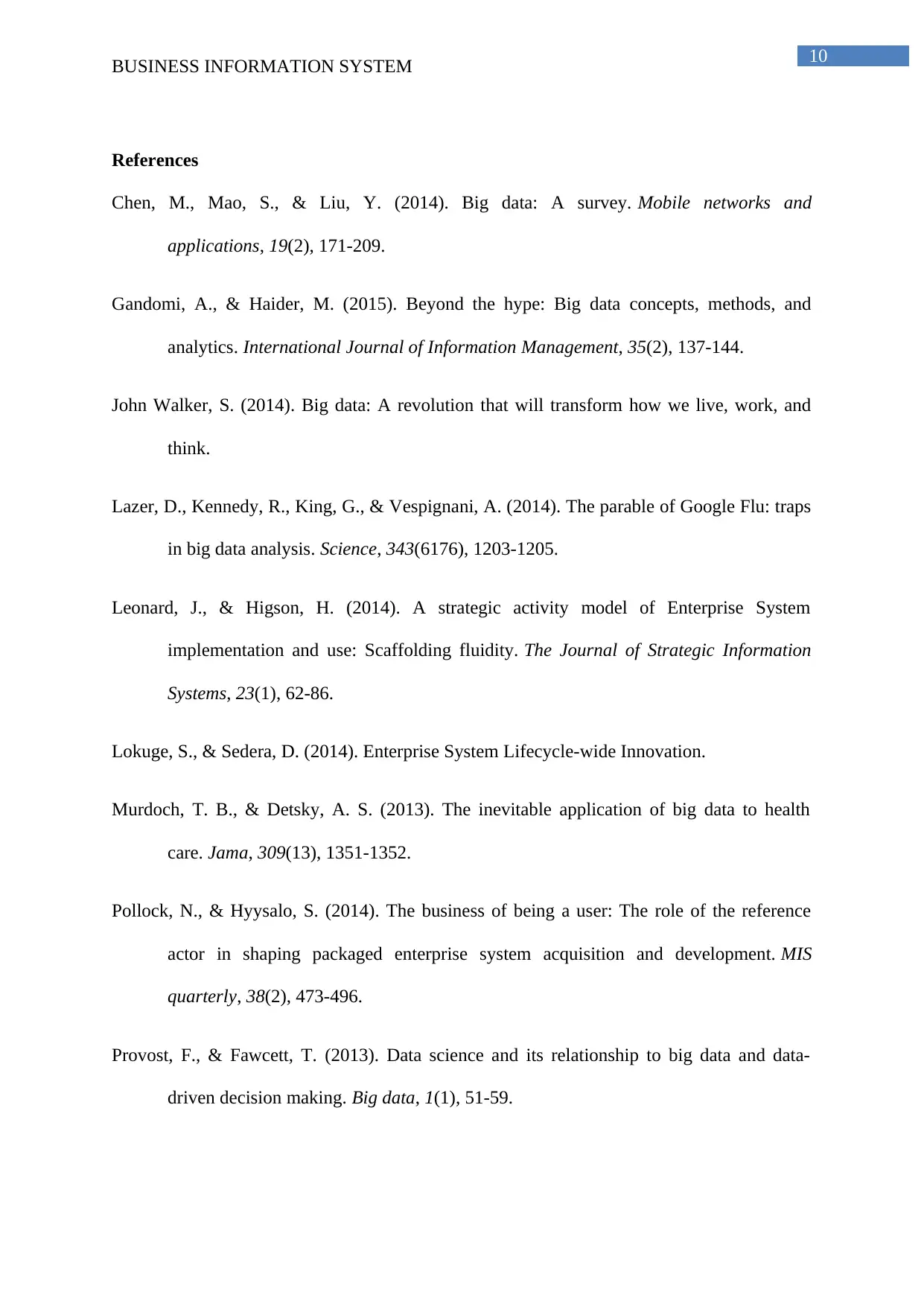
10
BUSINESS INFORMATION SYSTEM
References
Chen, M., Mao, S., & Liu, Y. (2014). Big data: A survey. Mobile networks and
applications, 19(2), 171-209.
Gandomi, A., & Haider, M. (2015). Beyond the hype: Big data concepts, methods, and
analytics. International Journal of Information Management, 35(2), 137-144.
John Walker, S. (2014). Big data: A revolution that will transform how we live, work, and
think.
Lazer, D., Kennedy, R., King, G., & Vespignani, A. (2014). The parable of Google Flu: traps
in big data analysis. Science, 343(6176), 1203-1205.
Leonard, J., & Higson, H. (2014). A strategic activity model of Enterprise System
implementation and use: Scaffolding fluidity. The Journal of Strategic Information
Systems, 23(1), 62-86.
Lokuge, S., & Sedera, D. (2014). Enterprise System Lifecycle-wide Innovation.
Murdoch, T. B., & Detsky, A. S. (2013). The inevitable application of big data to health
care. Jama, 309(13), 1351-1352.
Pollock, N., & Hyysalo, S. (2014). The business of being a user: The role of the reference
actor in shaping packaged enterprise system acquisition and development. MIS
quarterly, 38(2), 473-496.
Provost, F., & Fawcett, T. (2013). Data science and its relationship to big data and data-
driven decision making. Big data, 1(1), 51-59.
BUSINESS INFORMATION SYSTEM
References
Chen, M., Mao, S., & Liu, Y. (2014). Big data: A survey. Mobile networks and
applications, 19(2), 171-209.
Gandomi, A., & Haider, M. (2015). Beyond the hype: Big data concepts, methods, and
analytics. International Journal of Information Management, 35(2), 137-144.
John Walker, S. (2014). Big data: A revolution that will transform how we live, work, and
think.
Lazer, D., Kennedy, R., King, G., & Vespignani, A. (2014). The parable of Google Flu: traps
in big data analysis. Science, 343(6176), 1203-1205.
Leonard, J., & Higson, H. (2014). A strategic activity model of Enterprise System
implementation and use: Scaffolding fluidity. The Journal of Strategic Information
Systems, 23(1), 62-86.
Lokuge, S., & Sedera, D. (2014). Enterprise System Lifecycle-wide Innovation.
Murdoch, T. B., & Detsky, A. S. (2013). The inevitable application of big data to health
care. Jama, 309(13), 1351-1352.
Pollock, N., & Hyysalo, S. (2014). The business of being a user: The role of the reference
actor in shaping packaged enterprise system acquisition and development. MIS
quarterly, 38(2), 473-496.
Provost, F., & Fawcett, T. (2013). Data science and its relationship to big data and data-
driven decision making. Big data, 1(1), 51-59.
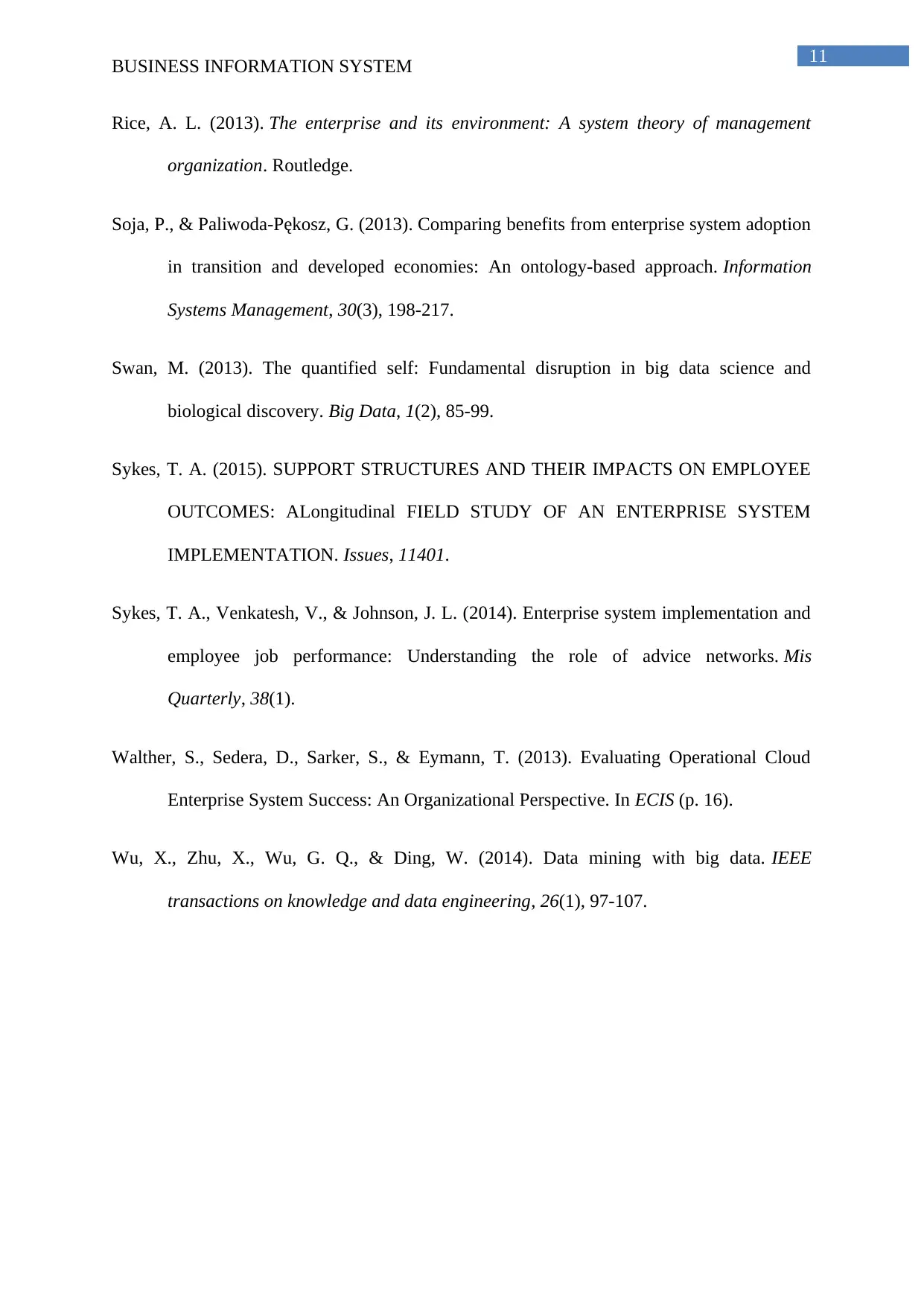
11
BUSINESS INFORMATION SYSTEM
Rice, A. L. (2013). The enterprise and its environment: A system theory of management
organization. Routledge.
Soja, P., & Paliwoda-Pękosz, G. (2013). Comparing benefits from enterprise system adoption
in transition and developed economies: An ontology-based approach. Information
Systems Management, 30(3), 198-217.
Swan, M. (2013). The quantified self: Fundamental disruption in big data science and
biological discovery. Big Data, 1(2), 85-99.
Sykes, T. A. (2015). SUPPORT STRUCTURES AND THEIR IMPACTS ON EMPLOYEE
OUTCOMES: ALongitudinal FIELD STUDY OF AN ENTERPRISE SYSTEM
IMPLEMENTATION. Issues, 11401.
Sykes, T. A., Venkatesh, V., & Johnson, J. L. (2014). Enterprise system implementation and
employee job performance: Understanding the role of advice networks. Mis
Quarterly, 38(1).
Walther, S., Sedera, D., Sarker, S., & Eymann, T. (2013). Evaluating Operational Cloud
Enterprise System Success: An Organizational Perspective. In ECIS (p. 16).
Wu, X., Zhu, X., Wu, G. Q., & Ding, W. (2014). Data mining with big data. IEEE
transactions on knowledge and data engineering, 26(1), 97-107.
BUSINESS INFORMATION SYSTEM
Rice, A. L. (2013). The enterprise and its environment: A system theory of management
organization. Routledge.
Soja, P., & Paliwoda-Pękosz, G. (2013). Comparing benefits from enterprise system adoption
in transition and developed economies: An ontology-based approach. Information
Systems Management, 30(3), 198-217.
Swan, M. (2013). The quantified self: Fundamental disruption in big data science and
biological discovery. Big Data, 1(2), 85-99.
Sykes, T. A. (2015). SUPPORT STRUCTURES AND THEIR IMPACTS ON EMPLOYEE
OUTCOMES: ALongitudinal FIELD STUDY OF AN ENTERPRISE SYSTEM
IMPLEMENTATION. Issues, 11401.
Sykes, T. A., Venkatesh, V., & Johnson, J. L. (2014). Enterprise system implementation and
employee job performance: Understanding the role of advice networks. Mis
Quarterly, 38(1).
Walther, S., Sedera, D., Sarker, S., & Eymann, T. (2013). Evaluating Operational Cloud
Enterprise System Success: An Organizational Perspective. In ECIS (p. 16).
Wu, X., Zhu, X., Wu, G. Q., & Ding, W. (2014). Data mining with big data. IEEE
transactions on knowledge and data engineering, 26(1), 97-107.
⊘ This is a preview!⊘
Do you want full access?
Subscribe today to unlock all pages.

Trusted by 1+ million students worldwide
1 out of 12
Related Documents
Your All-in-One AI-Powered Toolkit for Academic Success.
+13062052269
info@desklib.com
Available 24*7 on WhatsApp / Email
![[object Object]](/_next/static/media/star-bottom.7253800d.svg)
Unlock your academic potential
Copyright © 2020–2025 A2Z Services. All Rights Reserved. Developed and managed by ZUCOL.




